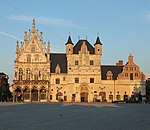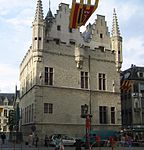Mechelen railway station
1835 establishments in BelgiumBuildings and structures in MechelenRailway stations in Antwerp ProvinceRailway stations in Belgium opened in 1835Use British English from August 2023

Mechelen railway station (Dutch: Station Mechelen, French: Gare de Malines) is a railway station in Mechelen, Antwerp, Belgium. The station opened on 5 May 1835 on railway lines 25, 27 and 53. The train services are operated by the National Railway Company of Belgium (NMBS/SNCB).
Excerpt from the Wikipedia article Mechelen railway station (License: CC BY-SA 3.0, Authors, Images).Mechelen railway station
Koning Albertplein,
Geographical coordinates (GPS) Address External links Nearby Places Show on map
Geographical coordinates (GPS)
| Latitude | Longitude |
|---|---|
| N 51.0175 ° | E 4.4836111111111 ° |
Address
Mechelen
Koning Albertplein
2800 (Mechelen)
Antwerp, Belgium
Open on Google Maps










